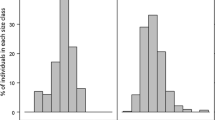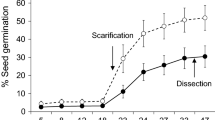Summary
Four shrub species of the Australian Proteaceae (Hakea sericea, H. gibbosa, H. suaveolens and H. salicifolia) were introduced to South African fynbos shrublands between 1840 and 1860. H. sericea is highly invasive, H. gibbosa and H. suaveolens are moderately invasive and H. salicifolia is not invasive. The allocation of reproductive energy, germinability, the ability to survive fires and to germinate in burnt and unburnt areas, and the nutrient content of seeds were assessed for the four species. The information was used to investigate whether the success of H. sericea relative to the other three species could be explained by the superior expression of any trait. The most important trait which separates H. sericea from the other species is its ability to produce a large seed bank in its adopted environment in the absence of seed predators. Seed production in H. sericea shrubs with an above-ground dry mass of 8 kg is four times greater than H. gibbosa and more than 16 times that of H. suaveolens. Although H. salicifolia also produces a large seed bank, its seeds are unable to survive fires due to inadequate insulation by the small follicles. The results are compared to dispersal and seed bank data for indigenous South African Proteaceae, which have low dispersal and suffer high pre-dispersal seed predation. We suggest that potential invasives in the fynbos can be identified as species that have: (i) a potentially high seed production that is limited by specialized predators; (ii) an ability to disperse over long distances; and (iii) are pre-adapted to frequent fires and low soil nutrients. The data also support the current strategy of combatting H. sericea using specialized insect seed predators.
Similar content being viewed by others
References
Bond W (1980) Fire and senescent fynbos in the Swartberg, southern Cape. S Afr For J 114:68–71
Bond WJ (1985) Canopy-stored seed reserves (serotiny) in Cape Proteaceae. S Afr J Bot 51:181–186
Burrows FM (1975) Wind-borne seed and fruit movement. New Phytol. 75:405–418
Cavers PB (1983) Seed demography. Can J Bot 61:3578–3590
Coetzee JH (1984) Insekte in assosiasie met Protea repens (L.) L. M Sc thesis, University of Stellenbosch
Czabator FJ (1962) Germination value: An index combining speed and completeness of pine seed germination. For Sci 8:386–396
Evenson WA (1983) Experimental studies of reproductive energy allocation in plants. In: Jones CE and Little RJ (eds) Handbook of experimental pollination biology. Scientific and Academic Editions, New York, pp 249–274
Fugler SR (1983) The control of silky hakea in South Africa. Bothalia 14:977–980
Gill AM, Neser S (1984) Acacia cyclops and Hakea sericea at home and abroad. In: Dell B (ed) Proceedings, 4th international conference on mediterranean ecosystems. University of Western Australia, Nedlands, pp 57–58
Goldblatt P (1978) An analysis of the flora of southern Africa: its characteristics, relationships and origins. Ann Miss Bot Gar 65:369–436
Green DS (1980) The terminal velocity and dispersal of spinning samaras. Am J Bot 67:1218–1224
Hall AV (1979) Invasive weeds. In: Day J, Siegfried WR, Louw GN and Jarman ML (eds) Fynbos ecology: a preliminary synthesis. S Afr Nat Sci Prog Report 40, CSIR, Pretoria, pp 133–147
Harper JL (1977) Population biology of plants. Academic Press, London
Harper JL, Ogden J (1970) The reproductive strategy of higher plants. I. The concept of strategy with special reference to Senecio vulgaris L. J Ecol 58:681–698
Hickman JC, Pitelka LF (1975) Dry weight indicates energy allocation in ecological strategy analysis of plants. Oecologia 21:117–121
International Seed Testing Association (1976) International rules for seed testing, Annexes 1976. Seed Sci and Technol 4:51–177
Jackson ML (1958) Soil chemical analysis. Prentice Hall, New Jersey
Johnson LAS, Briggs BG (1963) Evolution in the Proteaceae. Aust J Bot 11:21–61
Kluge RL (1983) The hakea fruit weevil, Erytenna consputa (Coleoptera: Curculionidae), and the biological control of Hakea sericea Schrader in South Africa. Ph D thesis, Rhodes University, Grahamstown
Lamont BB, Collins BG, Cowling RM (1985) Reproductive biology of the Proteaceae in Australia and South Africa. Proc Ecol Soc Aust 14:213–224
Macdonald IAW (1984) Is the fynbos biome especially susceptible to invasion by alien plants? A re-analysis of avialable data. S Afr J Sci 80:369–377
Macdonald IAW, Jarman ML (Eds) (1984) Invasive alien organisms in the terrestrial ecosystems of the fynbos biome, South Africa. SA National Scientific Programmes Report 85. CSTR, Pretoria
Macdonald IAW, Jarman ML, Beeston P (Eds) (1985) Management of invasive alien plants in the fynbos biome. SA National Scientific Programmes Report 111:1–140. CSIR, Pretoria
Macdonald IAW, Richardson DM (1986) Alien species in terrestrial ecosystems of the fynbos biome. In: Macdonald IAW, Kruger FJ and Ferrar AA (eds) The ecology and control of biological invasions in South Africa. Oxford University Press, Cape Town, in press
Manders PT (1986) Seed dispersal and seedling recruitment in Protea laurifolia. S Afr J Bot 52:421–424
Mitchell DT, Allsopp N (1984) Changes in the phosphorus composition of seeds of Hakea sericea (Proteaceae) during germination under low phosphorus conditions. New Phytol 96:239–247
Mooney HA, Hamburg SP, Drake JA (1986) Invasions of plants and animals into California. In: Mooney HA & Drake JA (eds) Ecology of biological invasions of North America and Hawaii. Springer-Verlag, New York, pp 250–272
Murphy J, Riley JP (1962) A modified single solution method for the determination of phosphate in natural waters. analytico Chimica Acta 27:31–36
Neser S (1968) Studies on some potentially useful insect enemies of the needle bush (Hakea spp.-Proteaceae). Ph D thesis. Australian National University, Canberra
Neser S (1978a) Rock hakea. In: Stirton CH (ed) Plant invaders. Beautiful, but dangerous. Department of Nature and Environmental Conservation of the Cape Provincial Administration, Cape Town, pp 72–75
Neser S (1978b) Sweet hakea. In: Stirton CH (ed) Plant invaders. Beautiful, but dangerous. Department of Nature and Environmental Conservation of the Cape Provincial Administration, Cape Town, pp 80–83
Neser S, Kluge RL (in press) A seed-feeding insect showing promise in the control of a woody invasive plant: The weevil Erytenna consputa Pascoe on Hakea sericea (Proteaceae) in South Africa. Proc VI. Int Symp Biol Contr Weeds, Vancouver
Richardson DM (1985) Studies on aspects of the integrated control of Hakea sericea in the south-western Cape Province, South Africa. M Sc thesis, University of Cape Town
Richardson DM, Van Wilgen BW (1984) Factors affecting the regeneration success of Hakea sericea. S Afr For J 131:63–68
Samson DA, Werk KS (1986) Size-dependent effects in the analysis of reproductive effort in plants. Am Nat 127:667–680
Slingsby P, Bond WJ (1985) The influence of ants on the dispersal distance and seedling recruitment of Leucospermum conocarpodendron (L.) Buek (Proteaceae). S Afr J Bot 51:30–34
Smith VR (1980) A phenol-hypochlorite determination of ammonium-nitrogen in kjeldahl digests of plant tissue. Communications in soil science and plant analysis 11:709–722
Van Wilgen BW, Richardson DM (1985) The effects of alien shrub invasions on vegetation structure and fire behaviour in South African fynbos shrublands: a simulation study. J appl Ecol 22:955–966
Versfeld DB, Van Wilgen BW (1986) Impacts of woody aliens on ecosystem properties. In: Macdonald IAW, Kruger FJ and Ferrar AA (eds) The ecology and control of biological invasions in South Africa. Oxford University Press, Cape Town (in press)
Author information
Authors and Affiliations
Rights and permissions
About this article
Cite this article
Richardson, D.M., Van Wilgen, B.W. & Mitchell, D.T. Aspects of the reproductive ecology of four australian Hakea species (Proteaceae) in South Africa. Oecologia 71, 345–354 (1987). https://doi.org/10.1007/BF00378706
Received:
Issue Date:
DOI: https://doi.org/10.1007/BF00378706




